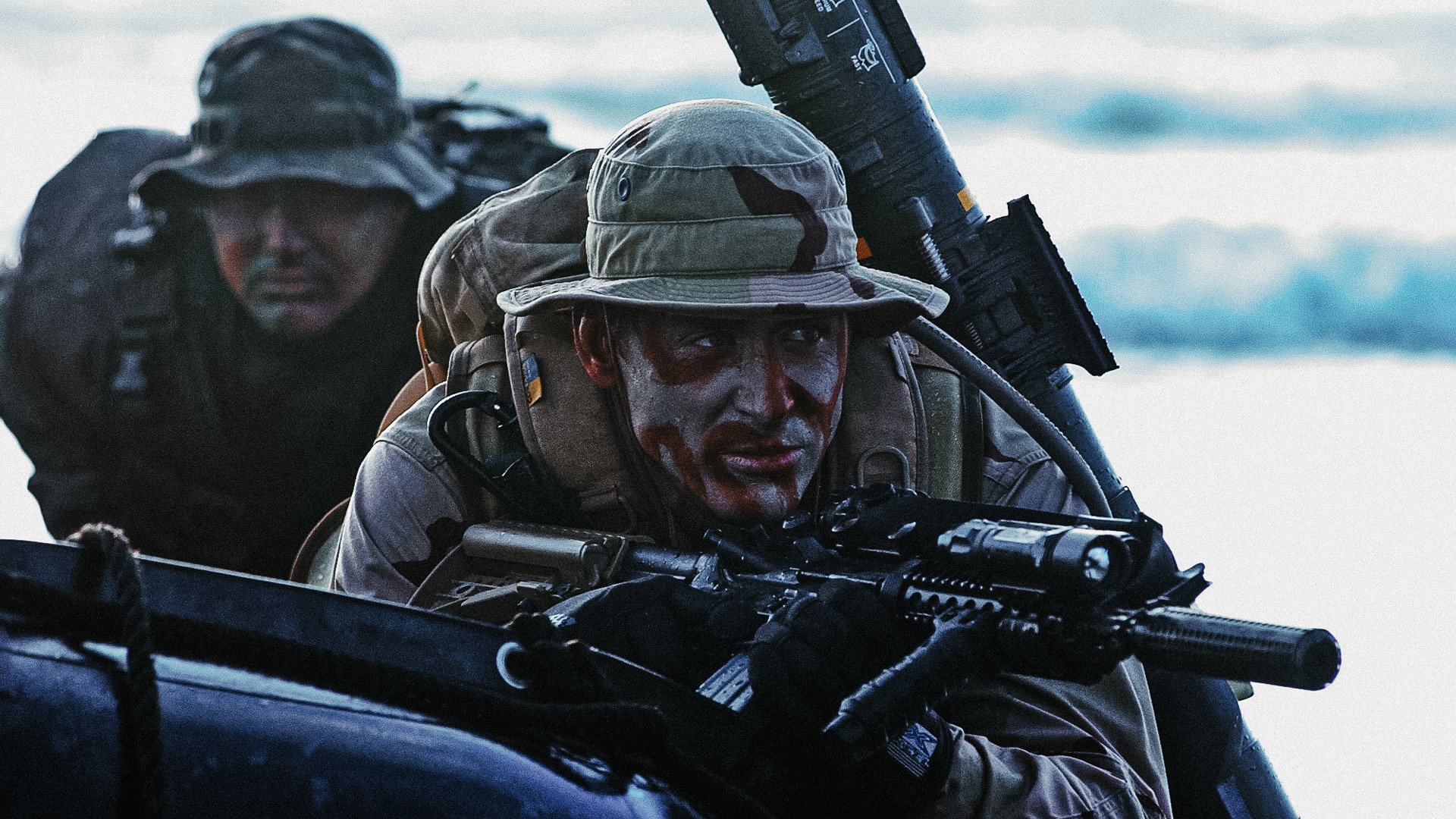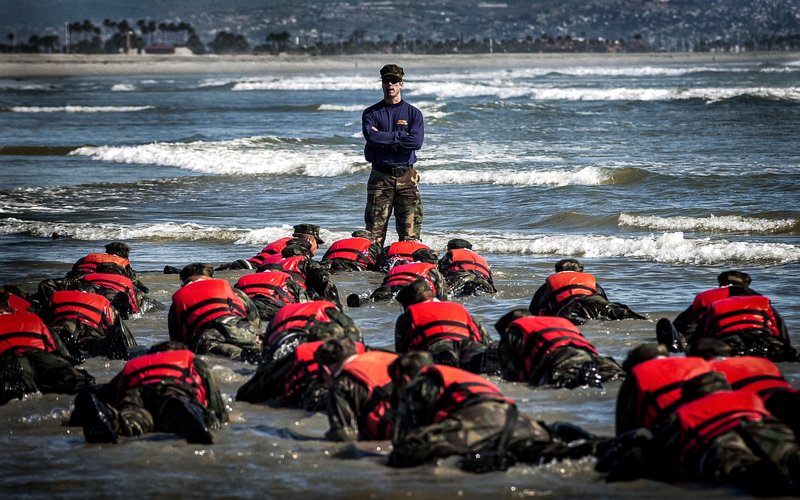
US Navy SEALs in 2004. US Navy photo.
On Dec. 8, 2012, commandos from the elite Naval Special Warfare Development Group descended a mountain to reach a small compound overlooking the Tangi Valley in Afghanistan. Their mission was to rescue Dr. Dilip Joseph, an American citizen who had been abducted by Taliban insurgents some days prior.
As the SEALs moved on foot, PO1 Nicholas Cheque, their pointman, spotted a Taliban fighter standing guard outside the target building. Cheque engaged the man with his rifle and sprinted to the building’s entrance, which was covered with wool blankets fastened to the ceiling and walls.
Cheque weaved through the blankets and was immediately struck in the head by an enemy round. Directly behind him was Chief Edward Byers Jr. Bypassing Cheque, who lay dying on the floor, Byers confronted the gunman and shot him at close range. Then he pounced on another man, using his knees to pin him to the ground before shooting him, too.

Master Chief Edward Byers Jr. conducted nine combat deployments during his career. US Navy photo.
Byers called out for Joseph by name and heard someone reply in English. Scanning the room through his night-vision goggles, he spotted the doctor and ran to him. At that point, Byers realized a third Taliban fighter was in the room. He grabbed the man by the throat and pinned him against the wall, allowing more SEALs to safely enter the building and kill the remaining insurgents.
The SEALs extracted Joseph by helicopter. Tragically, Cheque succumbed to his wounds after they returned to base. According to Byers, four SEALs who had participated in the mission were awarded the Navy Cross, including Cheque (posthumously). Byers himself received the Medal of Honor, becoming one of only seven SEALs to be bestowed the nation’s highest commendation for combat valor — though, some would say it’s been earned by many more.
Related: Why Are These 5 Navy SEAL Movies So Popular?
SEAL Training Pipeline

A 1st phase BUD/S instructor overseeing training for class 245. Photo by Photographer's Mate 2nd Class Eric S. Logsdon.
As of 2023, all SEAL candidates must first attend Navy recruit training in Great Lakes, Illinois. Next, they travel to Coronado, California, to attend the five-week Naval Special Warfare Preparatory Course. Those who pass the course move on to Naval Special Warfare Orientation, a two-week introduction to ocean swims, sand running, and the obstacle course. Finally, those who are deemed ready to move on are assigned a class number to start the first phase of Basic Underwater Demolition/SEAL (BUD/S) training.
BUD/S consists of three 7-week phases. The first phase is designed to weed out mentally and physically unfit candidates. The culminating event, known as “Hell Week,” is a five-day crucible intended to simulate stressors experienced in combat. The second phase introduces candidates to combat diving. It includes a “pool competency” test that requires students to solve problems underwater, often with a limited air supply. The third phase is the land warfare section, where students learn basic weapons handling and tactics.
After completing BUD/S, candidates attend the 26-week SEAL Qualification Training (SQT). There, they undergo more specialized training to prepare them for joining a SEAL platoon. The blocks of instruction include medical, demolitions, and cold weather survival. Following SQT, candidates must attend Survival, Evasion, Resistance, and Escape (SERE) school and parachute training to obtain their Trident warfare designator pin signifying their official status as SEALs. Finally, the new SEALs arrive at their first SEAL Team.
Related: Hunter, Frogman, Sniper, Spy: Retired SEAL Terry Houin Is Just Getting Started
Before SEALs, They Were Frogmen

Navy frogmen from UDT-11 seen here during the famous recovery of the Apollo 11 crew from the Pacific Ocean after completing the first-ever moon landing. Photo courtesy of NASA.
The history of Naval Special Warfare dates back to World War II. In the 1940s, NSW had several special operations units that are considered predecessors to the SEALs. They included the Office of Strategic Services Maritime Unit, the Scouts & Raiders, Naval Combat Demolition Units, and the Underwater Demolition Teams, or UDTs, which are the unit most ingrained in the SEAL’s lineage.
On Jan. 1, 1962, President John F. Kennedy established the Navy SEALs with SEAL Team 1 in Coronado, California, and SEAL Team 2 in Little Creek, Virginia. The SEALs would establish their legendary reputation in Vietnam, where they conducted clandestine missions against the Viet Cong.
In the 1980s, the UDTs were dissolved to create additional SEAL Teams. For example, UDT-11, whose members famously recovered the Apollo 11 crew from the Pacific Ocean after they’d completed the first-ever moon landing, became SEAL Team 5.
Related: The Flower-Wearing Frogman Who Welcomed Apollo 11 Astronauts Back to Earth
How Are the SEAL Teams Structured?

A Navy SEAL sniper wearing a ghillie suit during a recruitment photoshoot. US Navy photo.
Eventually, the Navy SEALs grew so much in number that they needed to be reorganized accordingly. Today, the teams are structured under various Naval Special Warfare Groups. For example, SEAL Teams 1, 3, 5, and 7 belong to NSWG-1 at the Naval Amphibious Base Coronado in California. SEAL Teams 2, 4, 8, and 10 fall under NSWG-2 at Joint Expeditionary Base–Little Creek in Virginia.
In 2021, NSWG-3 and NSWG-10 were combined to create NSWG-8, which is also based in Little Creek. NSWG-8 contains some of the SEAL’s most advanced mission-specific teams, including the SEAL Delivery Vehicle [SDV] Teams and the Special Reconnaissance Teams. The Special Reconnaissance Teams were created from scratch in the mid-2000s to provide other SEAL Teams with advanced intelligence collection capabilities.
NSWG-11 contains the only two SEAL reserve units — Team 17 and Team 18. There is no SEAL Team 9.
Historically, SEAL Team 6 served as the Navy’s first special missions unit. Today, the team is called the Naval Special Warfare Development Group (DEVGRU). Its members work alongside other special mission units from the Army and Air Force at Joint Special Operations Command, or JSOC, and they have conducted some of the most high-profile special operations missions in history.
Related: Why Navy SEALs Wore Blue Jeans in Vietnam Instead of Jungle Fatigues
Most High-Profile SEAL Missions
The SEALs have participated in every major American conflict since the Vietnam War. Their most high-profile missions were carried out by DEVGRU. Here are a few of the most noteworthy:
- Operation Gothic Serpent. In October 1993, a team of four DEVGRU SEAL snipers were deployed to Somalia and fought in the Battle of Mogadishu, later made famous by the 2001 movie Black Hawk Down.
- Operation Takur Ghar. In March 2002, DEVGRU SEAL Britt Slabinski earned the Medal of Honor for his actions while attempting to rescue SEAL Neil Roberts, who had plummeted to the ground during a helicopter insertion targeting Al-Qaeda fighters in the mountains of Afghanistan.
- In April 2009, off the coast of Somalia, DEVGRU SEAL snipers killed a group of Somali pirates that had hijacked the Maersk Alabama and taken its captain, Richard Phillips, hostage. The operation was later immortalized in the 2013 film Captain Phillips.
- Operation Neptune Spear. In May 2011, DEVGRU SEALs killed al Qaeda leader Usama Bin Laden while raiding his compound in Pakistan. The story was told in the film Zero Dark Thirty.
Read Next: The Bull Frog: How The SEALs Honor Their Most Seasoned Commando

Matt Fratus is a history staff writer for Coffee or Die. He prides himself on uncovering the most fascinating tales of history by sharing them through any means of engaging storytelling. He writes for his micro-blog @LateNightHistory on Instagram, where he shares the story behind the image. He is also the host of the Late Night History podcast. When not writing about history, Matt enjoys volunteering for One More Wave and rooting for Boston sports teams.
BRCC and Bad Moon Print Press team up for an exclusive, limited-edition T-shirt design!
BRCC partners with Team Room Design for an exclusive T-shirt release!
Thirty Seconds Out has partnered with BRCC for an exclusive shirt design invoking the God of Winter.
Lucas O'Hara of Grizzly Forge has teamed up with BRCC for a badass, exclusive Shirt Club T-shirt design featuring his most popular knife and tiomahawk.
Coffee or Die sits down with one of the graphic designers behind Black Rifle Coffee's signature look and vibe.
Biden will award the Medal of Honor to a Vietnam War Army helicopter pilot who risked his life to save a reconnaissance team from almost certain death.
Ever wonder how much Jack Mandaville would f*ck sh*t up if he went back in time? The American Revolution didn't even see him coming.
A nearly 200-year-old West Point time capsule that at first appeared to yield little more than dust contains hidden treasure, the US Military Academy said.












